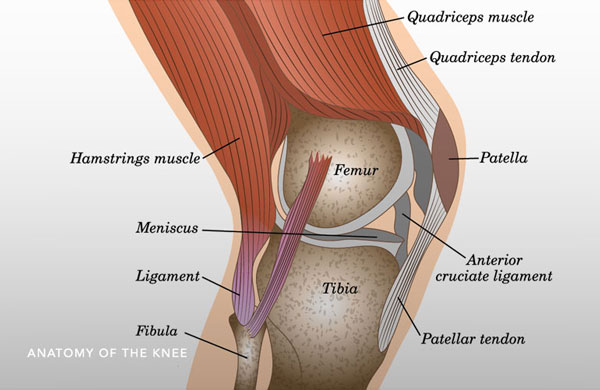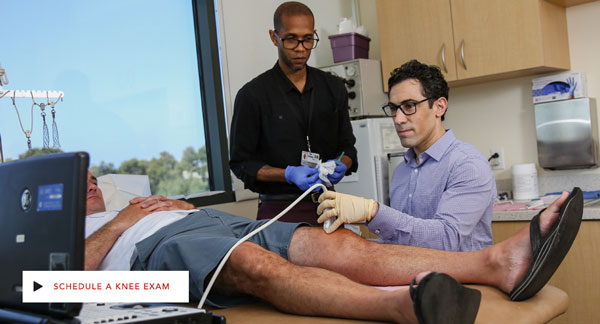
Knee mechanics
The kneecap is called the Patella. It connects thigh muscles to the shinbone. The patella is made of bone and is kept in position by the patellofemoral ligaments. This allows the patella to move freely. When the knee bends and straightens the patella moves straight up and down in a grove in the thighbone. So long as it stays in the groove you can move easily.
What is patellar instability?
Patellar instability is a common and disabling condition often caused by a sports injury. A blow to the knee can force the patella to slide off of the groove and dislocate. When it dislocates there is pain and loss of function. Treatment will relieve pain even if the patella slides back in place.

Even when the knee cap doesn’t dislocate, an unstable kneecap will cause pain, especially when the patient walks on uneven surfaces, climbs stairs or just rolls over in bed.
Chronic patellar instability is the name for the condition where the kneecap only partially slides out of its groove. This is called subluxation. Subluxation is more common than kneecap dislocation.
What causes kneecap instability?
50-60% of patellar dislocations are sports – related and often involve damage to the patellofemoral ligament. Repeated partial or complete dislocations cause knee instability and damage the cartilage in the joint. The longer the instability lasts the more likely there will be cartilage injuries.
Kneecap instability may also result from a structural problem with the kneecap including an uneven or shallow groove, loose ligaments, a congenital defect, or a combination of variables that make the knee vulnerable to instability.
Kneecap instability is most often diagnosed in teens and young adults. There is a significant risk of additional episodes of kneecap instability after the initial dislocation.
What are the symptoms?
When the kneecap slips out of place there is pain and loss of function.
- The knee buckles and cannot support you
- The knee cap slides off to one side – called subluxation
- The knee catches during movement
- Pain in the front of the knee that worsens with activity
- Creaking or cracking sounds when the knee is moved
- Severe pain even when sitting
- Sudden swelling and stiffness
- Inability to walk or straighten the leg
How is it diagnosed?
Knee Surgeon Dr. Erik Stark will review your medical history, discuss specific symptoms, how the injury happened, and conduct a physical exam to evaluate range of motion and tenderness, and visually inspect the knee.
Imaging tests are ordered to diagnose patellar instability. X-rays will reveal anatomic abnormalities. MRI will evaluate the soft tissues, but often Dr. Stark can diagnose instability from a physical exam and x-rays.

What are the treatments for patellar instability?
Treatment is aimed at stabilizing the knee cap and repairing any ligament or cartilage damage. Treatment options depend on the extent of damage from the traumatic event.
A kneecap dislocation requires prompt medical attention. The kneecap must be returned to its proper location. This is accomplished with a reduction. Dr. Stark will apply gentle force to push the kneecap back to its proper position. Sometimes the kneecap will snap back in place on its own. Conservative treatment will include RICE rest, ice, compression and elevation; and physical therapy to strengthen the muscles to prevent the kneecap from moving out of its groove.
Repeated dislocations will damage the kneecap and the cartilage at the end of the thighbone, and loose cartilage may float into the joint and will need to be removed. Knee arthroscopy will be used to correct the damage.
Surgical treatment may be necessary when the patellofemoral ligaments are damaged. The surgery will reconstruct the damaged ligaments, and dramatically reduce recurrent subluxation or dislocation. In the vast majority of cases surgery will provide excellent functional outcomes. Dr. Stark has office in Carlsbad.
Related Topics
- Anterior Cruciate Ligament (ACL) Tear/Reconstruction
- Knee Replacement (Partial and Total Knee Replacement)
- Collateral Ligament (MCL / LCL) Tear/Reconstruction
- Meniscus Tear/Repair
- Multi-Ligament Injuries
- Patellar/Knee Cap Instability
- Posterior Cruciate Ligament (PCL) Tear/Reconstruction
- Tendon Ruptures (Patella Quad Tendon Hamstring)
- Trochleoplasty
